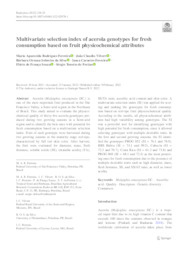Multivariate selection index of acerola genotypes for fresh consumption based on fruit physicochemical attributes.
Multivariate selection index of acerola genotypes for fresh consumption based on fruit physicochemical attributes.
Author(s): FERREIRA, M. A. R.; VILVERT, J. C.; SILVA, B. O. S. da; FERREIRA, I. C.; SOUZA, F. de F.; FREITAS, S. T. de
Summary: Acerola (Malpighia emarginata DC.) is one of the most important fruit produced in the São Francisco Valley, a Semi-arid region in the Northeast of Brazil. This study aimed to evaluate the physicochemical quality of thirty-fve acerola genotypes produced during two growing seasons in a Semi-arid region and to identify the best ones with potential for fresh consumption based on a multivariate selection index. Fruit of each genotype were harvested during two growing seasons at the maturity stage red-ripe, characterized by full red skin color. After harvest, the fruit were evaluated for diameter, mass, fesh frmness, soluble solids (SS), titratable acidity (TA) SS/TA ratio, ascorbic acid content and skin color. A multivariate selection index (SI) was applied for scoring and ranking the genotypes for fresh consumption based on red-ripe fruit physicochemical quality. According to the results, all physicochemical attributes had high variability among genotypes. The SI was a powerful tool for identifying genotypes with high potential for fresh consumption, since it allowed selecting genotypes with multiple desirable traits. In the frst and second growing seasons, the SI identifed the genotypes PROG 052 (SI = 76.1 and 78.9), BRS Rubra (SI = 74.1 and 99.5), Cabocla (SI = 72.3 and 70.7), Costa Rica (SI = 61.2 and 73.8) and PROG 069 (SI = 68.1 and 72.4) as the most promising ones for fresh consumption due to the presence of multiple desirable traits such as high diameter, mass, fesh frmness, SS, and SS/AT ratio, as well as lower acidity.
Publication year: 2022
Types of publication: Journal article
Unit: Embrapa Semi-arid Region
Observation
Some of Embrapa's publications are published as ePub files. To read them, use or download one of the following free software options to your computer or mobile device. Android: Google Play Books; IOS: iBooks; Windows and Linux: Calibre.
Access other publications
Access the Agricultural Research Database (BDPA) to consult Embrapa's full library collection and records.
Visit Embrapa Bookstore to purchase books and other publications sold by Embrapa.

